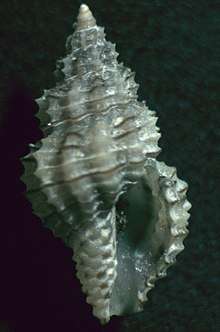Cyrillia linearis
Cyrillia linearis is a species of sea snail, a marine gastropod mollusk in the family Raphitomidae.[1]
| Cyrillia linearis | |
|---|---|
 | |
| Shell of Cyrillia linearis | |
| Scientific classification | |
| Kingdom: | Animalia |
| Phylum: | Mollusca |
| Class: | Gastropoda |
| Clade: | Caenogastropoda |
| Clade: | Hypsogastropoda |
| Clade: | Neogastropoda |
| Superfamily: | Conoidea |
| Family: | Raphitomidae |
| Genus: | Cyrillia |
| Species: | C. linearis |
| Binomial name | |
| Cyrillia linearis (Montagu, 1803) | |
| Synonyms | |
| |
Description
The shell is fusiform and turriculate. It has an elevated and acute spire. The twelve whorls are convex and longitudinally costated (twelve ribs on the body whorl). They are transversally sharply striated with 6-7 elevated lines, which run along the volutions. They are rather broader over the ribs and very sharp between them The outer lip is thickened on the outside with an obtuse varix or rib, but smooth within. The siphonal canal is short, rather broad and slightly inflected.[2]
Distribution
This marine species occurs in European waters from Norway to the Azores; in the Mediterranean Sea. Fossils were found in Pliocene strata in Italy.
gollark: They actually do run quite hot, you know.
gollark: By replacing the USB chip with a PCIe passthrough board.
gollark: Technically, you can get PCIe with some hax.
gollark: Oh, right, I also needed a heatsink case or fan.
gollark: My servers do storage too.
References
- MolluscaBase (2019). MolluscaBase. Cyrillia linearis (Montagu, 1803). Accessed through: World Register of Marine Species at: http://www.marinespecies.org/aphia.php?p=taxdetails&id=1389226 on 2019-11-28
- Wood, Searles Valentine. A Monograph of the Crag Mollusca: With Descriptions of Shells from the Upper Tertiaries of the British Isles. Vol. 1. Johnson, 1848.
External links
- Montagu, G. (1803). Testacea Britannica or Natural History of British Shells, Marine, Land, and Fresh-Water, Including the Most Minute: Systematically Arranged and Embellished with Figures. J. White, London, Vol. 1, xxxvii + 291 pp;; Vol. 2, pp. 293–606, pl. 1-16
- Bucquoy E., Dautzenberg P. & Dollfus G. (1882-1886). Les mollusques marins du Roussillon. Tome Ier. Gastropodes. Paris, J.B. Baillière & fils 570 p., 66 pl.
- Smith E.H. (1967). Two new species of British turrids. The Veliger. 10(1): 1-4
- Donovan E. (1800-1804). The natural history of British shells : including figures and descriptions of all the species hitherto discovered in Great Britain, systematically arranged in the Linnean manner, with scientific and general observations on each; in five vo by E. Donovan
- Scacchi A. (1833). Osservazioni Zoologiche. Napoli, Tipi della Società Tipografica. 1: 1-12
- Bellardi L. (1877), I molluschi dei terreni terziarii del Piemonte e della Liguria /
- Blainville H. M. (D. de) (1828-1830). Malacozoaires ou Animaux Mollusques. [in Faune Française. Levrault, Paris 320 p., 48 pl. [livr. 18 (1828), p. 1-80; livr. 2 (1829), p. 81-176; livr. 23 (1829), p. 177-240; livr. 28 (1830), p. 241-320 ]
- Risso, A. (1826-1827). Histoire naturelle des principales productions de l'Europe Méridionale et particulièrement de celles des environs de Nice et des Alpes Maritimes. Paris, Levrault:. . 3(XVI): 1-480, 14 pls
- https://doi.org/10.1093/mollus/eyz022
- Biolib.cz: Cyrillia linearis
- Natural History Museum, Rotterdam: Raphitoma linearis
| Wikimedia Commons has media related to Cyrillia linearis. |
This article is issued from Wikipedia. The text is licensed under Creative Commons - Attribution - Sharealike. Additional terms may apply for the media files.